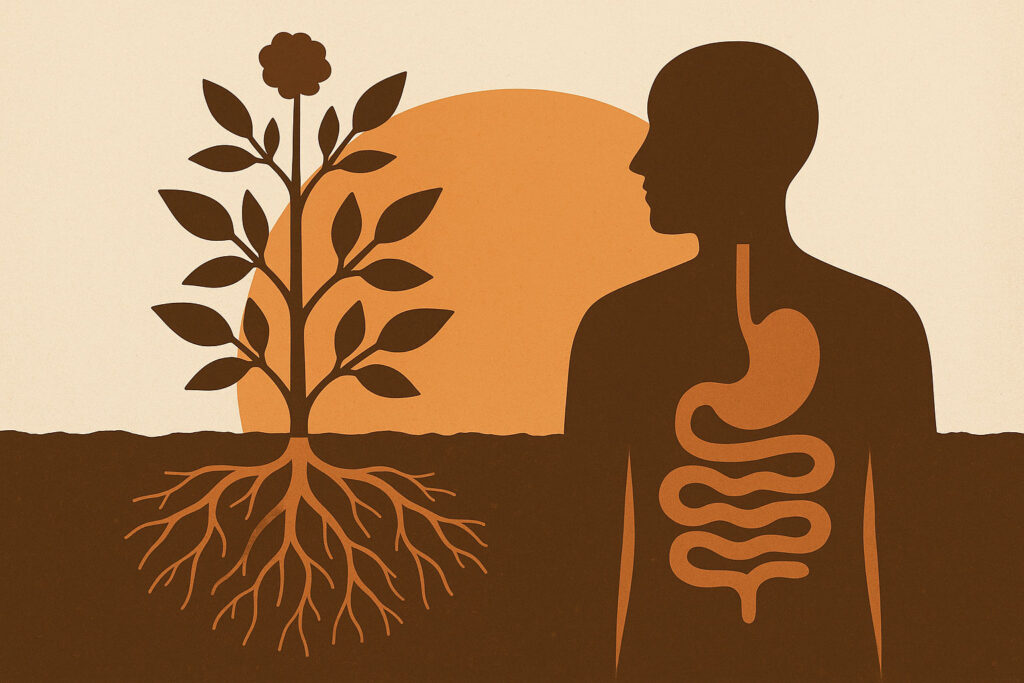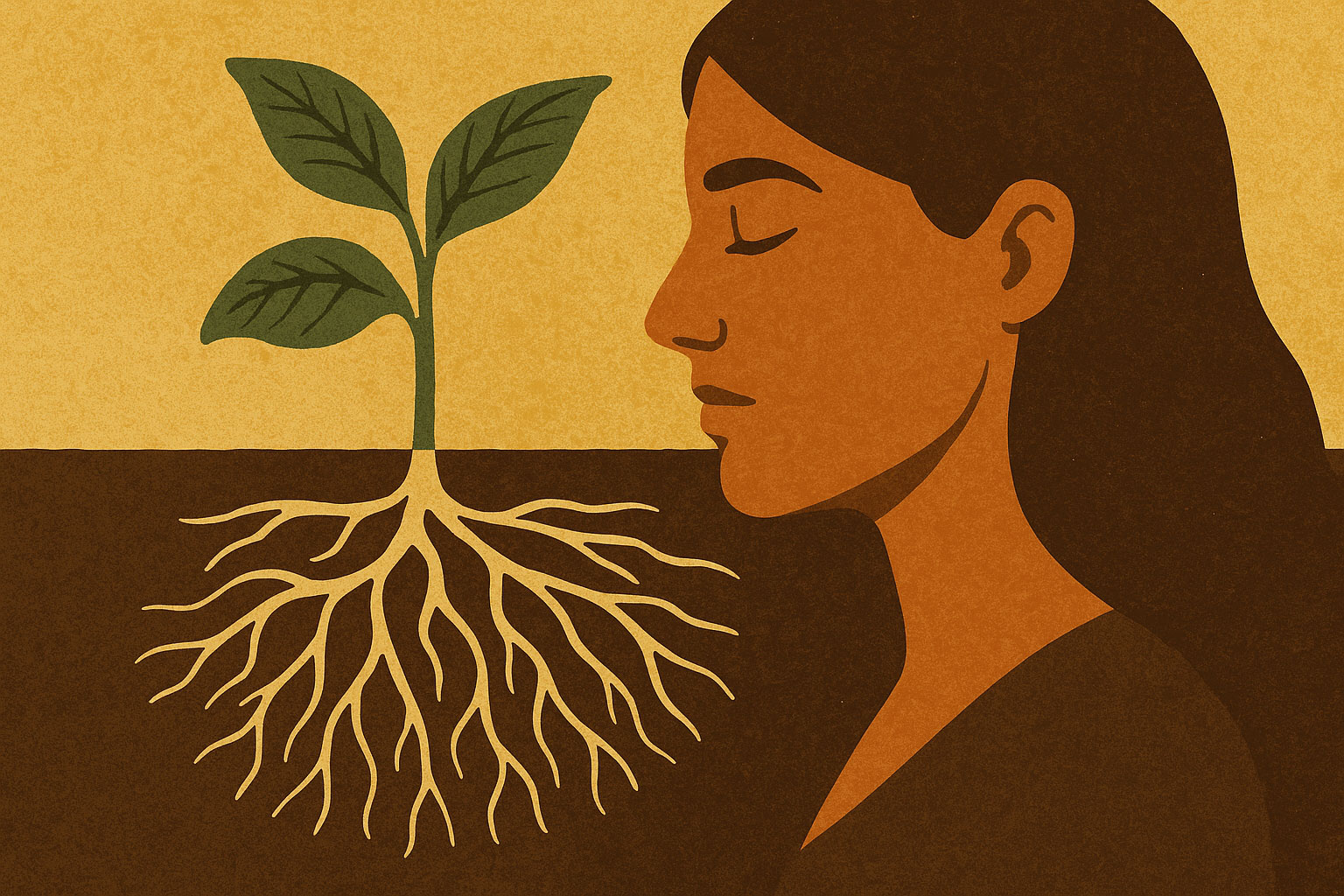
Breathing Your Way Back Home
A Buddhist parable of a blind turtle inspires reflection on life’s rarity, balancing samsara’s struggles with presence and spiritual homecoming.

We’ve spent more than a decade at Mother Magnolia Cultivation obsessing over soil biology – tuning fungal-to-bacterial balance, running compost teas, adding biological stimulants to our regimen. The longer we farm, the clearer the pattern has become: the soil’s hidden microbial community works a lot like the one inside us. Our gut biome and the soil biome are mirrors of one another and the way both collections of bacteria support life is astonishingly similar.
First, a definition. Biome blends bio- (life; Greek bios) with -ome (the whole set, as in genome). In classic ecology a biome a large living system – forest, desert, grassland – shaped by climate and dominant life. In practical farm talk, we use it locally: the soil biome or gut biome is the entire living community plus its habitat, food web, and signals.
Two key areas matter here. Plants operate at the rhizosphere – the thin halo around roots where biology is loudest – the root zone. We operate at the intestinal lining – the mucosal surface where our microbes live and talk to us – our colon primarily. Different places, but it’s the same logic.
Plants don’t eat compost or rock dust directly; they eat what microbes make available. Bacteria and fungi mineralize nitrogen, solubilize phosphorus, and unstick micronutrients bound in organic matter. In our gut, microbes play so many roles. Similar to soil microbes, they assist in managing indigestible, unavailable fiber – fermenting it into short-chain fatty acids (SCFAs) that feed our cells and support mineral uptake. They cue T-cells for immune support, synthesize K2 and B vitamins, unlock the bioactivity in polyphenols and keep pathogenic bacteria in check. In both arenas, the feast begins with what we can’t use – until microbes transform it.
In plants, roots produce exudates – sugars, amino acids, organic acids – that draw in and feed the microbiology at the root surface. This is akin to a plant payroll; the plants are paying the microbiology in sugars and other exudates. In return, microbes supply nutrients, extend reach, and help defend the root zone from pathogens. Our gut does something similar: the mucosal layer houses commensals (good bacteria) and supplies glycans (carbohydrates) they can use; in return they reinforce the mucosal barrier and synthesize vitamins. Health thrives where the interface is well-fed and well-guarded.
Even though we can’t hear it, healthy soil is always humming with signals; a nonstop biochemical conversation. Microbes craft phytohormones (like auxin), and trade what are known as quorum-sensing messages. Then – via mycorrhizal networks – they prime plant defenses before pathogens take hold. Our gut community has a similar communication between microbes and the host: these gut metabolites modulate immunity, motility, and even mood pathways (think serotonin). In the same way the soil web has an on-going dialogue where plants benefit from the bacteria, humans derive the same benefit as our gut bacteria unlock the nutrition which is the main cargo we are focused on here.

Species-rich soils buffer drought, pests, and nutrient swings. When soil microbiology is disturbed with heavy tillage, salts, or broad biocides, the beautiful party collapses. In the gut, dietary monotony, overly processed foods, antibiotics all undermine the same dialogue. To create microbial diversity in the soil and in the gut leads to much greater resistance to pests and pathogens. To achieve this, we need a diverse source of food for these microbes. The more diverse our diets are—across a broad spectrum of whole food – the more diverse and balanced our gut health. The same is true in the soil. Stoke the soil with a diverse collection of bacterial and fungal inputs that supports the microbiology in the soil, and the plants respond, healthier and happier.
Soil responds best to steady habits: balanced minerals, even moisture, compost and mulch, living cover crops to keep exudates flowing, and less tillage so habitat survives. The gut echoes that same rhythm: a rotation of fibers (prebiotics), polyphenol-rich plants, a bit of fermentation, decent sleep, less ultra-processing. Systems are maintained and they rebuild with gentle, repeated care.
How we apply this on the farm is straightforward.
We feed the soil web, not just the crop: well-finished composts and mulches; teas/extracts when they have a clear job (inoculating our soil pile); mycorrhizal inoculation where we have time to allow it to take hold and develop over time. We lower the noise: minimal disturbance, cautious application of salt-based slow release food, no broad-spectrum biocides unless there’s no alternative. We allow many random “weed” interlopers to grow alongside our plants because they produce different root exudates and recruit different crews. And we treat moisture as policy. We are moving to hand-watering to maintain the most efficient and consistent moisture levels in our pots. This is mission-critical to keep the microbiology diverse and thriving.
When the soil biome runs well, plants simply grow better. Period. The gut tells the same story. When these biomes are well-tended: steadier energy, clearer signals, fewer wild swings.
For growers and eaters, that’s the point. Build systems that convert potential into availability, protect the interface, keep the signals clear, and prioritize diversity. Whether you’re tending a garden bed or a body, this is how we create resilience and strength.
At Mother Magnolia, this isn’t theory. It’s the SOP we return to every week. When we get it right, inputs drop and yields, terpenes and stability rises. When we get it wrong, or if we drift, the message comes back very clear and quickly that we have lost the thread and we need to get things turned around quickly.
The soil and our gut are different but amazingly the same. Different biomes, but they share the same choreography. Feed what feeds you. Protect the edge where exchange happens. Let diversity carry the load. The rest – growth, strength, and recovery – has a way of following.
Soil is the foundation of everything we do at Mother Magnolia. If you want to dive deeper into why soil is the most essential part of your cultivation, check out our short video above. On our YouTube channel we share more lessons straight from the farm, plus extended modules in our online cultivation course for those who want to take their growing to the next level. And if you’re ready for a simple way to stoke your soil biome, explore our Flowerbird product line, starting with Soil Love.

A Buddhist parable of a blind turtle inspires reflection on life’s rarity, balancing samsara’s struggles with presence and spiritual homecoming.

Pablo Neruda’s “Keeping Quiet” teaches stillness amid chaos, reminding us that silence, breath, and presence restore peace and balance.

Inspired by Rory McIlroy’s Masters win and local golf struggles, this meditation explores resilience, nerves, and the courage to persevere.